As the 2021 tax filing season progresses, small businesses and self-employed taxpayers should make certain they are taking advantage of all of the tax deductions and opportunities available to them on their 2021 federal income tax returns. Tax savings increases after-tax cash flow and can mean greater return on investment and more money to fund expansion and the overall growth of the business.
The following are 10 top tax breaks for small businesses and business owners to keep in mind when finalizing their tax returns for 2021 and planning for 2022.
#1: Travel expenses. Work-related travel expenses are deductible. Qualifying expenses include airfare, hotels, rentals, car expenses, dry cleaning, and more. However, the business trip must be longer than a normal workday and require an overnight stay.
#2: Business meals. Up to 50% of the costs of business meals (both food and beverages) may be tax deductible if certain requirements are met. The deduction increases to 100% for meals at restaurants during 2021 and 2022 under a pandemic-related exception. To qualify as deductible, the meal must be business-related, the business owner (or an employee) must be present at the meal and the expense cannot be lavish or extravagant. In addition, the cost of the meal must be separately stated on the bill or receipt from any costs associated with entertainment, which are generally not deductible.
#3: Bonus depreciation. Bonus depreciation of 100% applies to qualifying new or original use property, as well as non-original use property, with a tax life of 20 years or less — this means that qualifying property can be fully expensed in the year it is placed in service. The 100% bonus depreciation deduction also applies to certain other classes of property, including “qualified improvement property,” which is a broad category of internal improvements made to non-residential buildings after the buildings are placed in service. From 2023, the bonus depreciation percentage decreases by 20% per year until it is fully phased out beginning in 2027. Businesses should consider placing qualifying assets in service before the end of 2022 to take advantage of the 100% rate.
Section 179 also allows a limited deduction of up to $1,050,000 for the full cost of qualifying assets placed in service during 2021 and is generally used by smaller businesses before taking bonus depreciation. Unlike bonus depreciation, Section 179 expense is not added back for AMT purposes and applies on an asset-by-asset basis rather than to an entire class of assets. The Section 179 deduction is phased out when asset purchases exceed $2,620,000 and no deduction may be claimed by businesses whose asset purchases exceed $3,670,000 for the year.
#4: Home office expenses. Self-employed taxpayers (such as sole proprietors, active shareholders in an S corporation and partners in a partnership) who work from home may be able to deduct a portion of their rent or mortgage as well as other direct and indirect costs as home office expenses. To qualify, the home office must be used exclusively and regularly as the primary place of business and meet certain other requirements. Employees who work from home are not able to deduct home office expenses.
Direct home office expenses include, for example, the costs of painting or repairing the home office and depreciation deductions for furniture and fixtures used in the home office. Examples of indirect home office expenses include the allocable share of utility costs, depreciation, and insurance for the home, as well as the allocable share of mortgage interest, real estate taxes, and casualty losses. The allocation is generally based on the square footage of the home office relative to the total square footage of the home.
#5: Start-up costs. Taxpayers starting a new business can deduct up to $5,000 for start-up costs related to getting the new business up and running, and another $5,000 for organizational costs related to setting up the entity’s governing provisions. Qualifying expenditures include costs for advertising, marketing, and research, and professional fees. Amounts that exceed the deduction limits are capitalized and amortized over 15 years.
#6: Tax accounting methods. Changing to optimal methods of accounting can provide opportunities for small businesses and their owners to reduce their current tax expense by accelerating deductions and/or deferring income. Changes in methods of accounting may also result in a significant favorable “catch-up” deduction in the year of the change. Automatic consent method changes can be made by filing a Form 3115 with the timely filed (including extensions) federal income tax return for the year of change and include the following, among others:
- Changing to the one-year deferral method for the recognition of certain advance payments, for example, goods or services, sale or license of computer software, use of intellectual property, or eligible gift card sales.
- Changing to accelerate deductions of qualifying software development costs incurred through 2021 to the year the costs are paid or incurred.
- Deducting in the year of payment certain prepaid expenses (for example, insurance premiums, property taxes, governmental permits and licenses, software maintenance) where the benefit period does not exceed 12 months.
- Accelerating deductions of accrued liabilities such as warranty costs, rebates, allowances, and product returns under the “recurring item exception.”
- Changing from the overall accrual method to the overall cash method of accounting. Small business taxpayers that qualify to use the overall cash method of accounting can file an automatic Form 3115 to switch from the accrual to the cash method if their average annual gross receipts over the preceding three years do not exceed $26 million for 2021 ($27 million for 2022).
- To be able to use the overall cash method for federal income tax purposes, C corporations and partnerships with a C corporation partner must meet the above-average annual gross receipts threshold. In contrast, there are generally no gross receipt limits for S corporations and partnerships without C corporation partners to use the cash method. Additionally, the cash method may not be used by any entity treated as a tax shelter under Section 448 (e.g., a syndicate).
#7: Compensation planning. An accrual basis corporation or partnership can take a deduction for bonuses properly accrued on its books in the current tax year but not actually paid to its employees until the following tax year provided (i) the overall bonus pool is fixed and determinable at year end, and (ii) the bonus is paid within the first two and a half months of the following tax year. However, the bonus must be paid before the end of the year if paid by a personal service corporation to an employee-owner, by an S corporation to any employee-shareholder, or by a C corporation to a direct or indirect majority owner. Bonuses paid to partners are subject to special guaranteed payment rules. Guaranteed payments are ordinary income to the receiving partner and must be included in taxable income for the tax year within which ends the partnership tax year in which the partnership deducted the payments.
Businesses that have not been taking advantage of the two-and-a-half-month rule can file an automatic Form 3115 request with their timely filed federal income tax returns for the year of change to elect this treatment for compensation such as bonuses, commissions, vacation pay, severance, and sick pay.
#8: PPP loan forgiveness. Businesses that have had a Paycheck Protection Plan (PPP) loan forgiven may exclude the amount of the forgiveness from their taxable income. A partnership or S corporation may treat the excluded amount as tax-exempt income that increases a partner’s or S-corporation shareholder’s tax basis in the pass-through entity, which is the starting point for determining the amount of the pass-through entity’s losses that the partner or shareholder may deduct. For this purpose, the tax-exempt income associated with the PPP loan forgiveness may be treated as received or accrued (i) as the eligible expenses are paid or incurred, (ii) when the application for PPP loan forgiveness is filed, or (iii) when the PPP loan forgiveness is granted.
#9: Section 199A qualified business income deduction. Non-corporate owners of partnerships, sole proprietorships, and S corporations may be entitled to a deduction of up to 20% of their qualified business income (within certain limitations based on the taxpayer’s taxable income, whether the taxpayer is engaged in a service-type trade or business, the amount of W-2 wages paid by the business and the unadjusted basis of certain property held by the business). A safe harbor is available to individuals and owners of pass-through entities with respect to real estate rental businesses.
#10: Bad debts and worthless investments. Accrual basis taxpayers may be able to claim a full or partial deduction for a business bad debt in the year the debt becomes wholly or partially worthless. Also, if a taxpayer owns stock in a business or an interest in a partnership that becomes wholly worthless during the taxable year, the taxpayer may recognize a capital loss for the adjusted tax basis of the ownership interest at the time of worthlessness.
Planning for 2022
It is never too late to begin planning for the future. Now is the time for small businesses and business owners to consider opportunities for optimizing their current and future tax liabilities. Some of these include:
- Reevaluating the choice of entity decision, taking into account a number of relevant factors including tax rates, availability of the qualified business income deduction, cost of conversion, and much more.
- Entity restructuring to simply the current structure by combining related businesses in a tax-free manner. Entity restructuring can eliminate intercompany loans as well as minimize the impact of the business loss deduction limitations that might otherwise apply to owners of pass-through entities and sole proprietorships.
- Performing cost segregation studies to maximize depreciation for taxpayers engaging in real property or other large asset investments.






